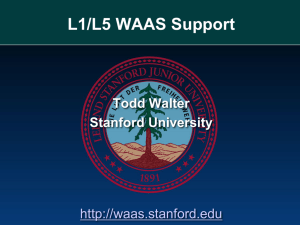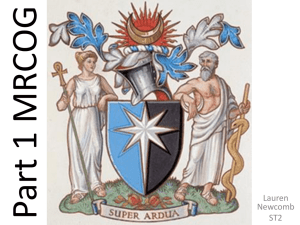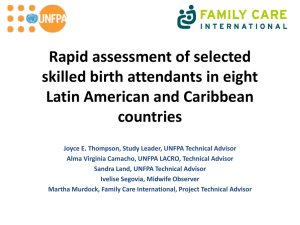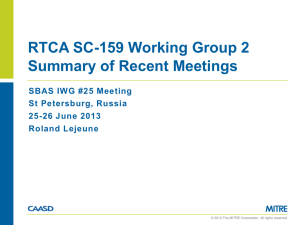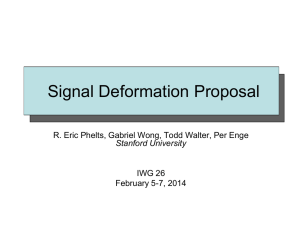SBAS GEO Satellite Selection v7
advertisement
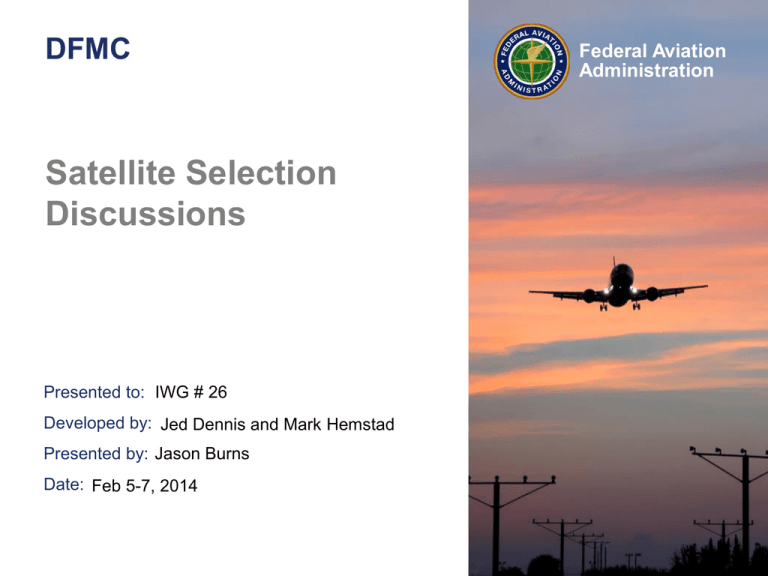
DFMC Satellite Selection Discussions Presented to: IWG # 26 Developed by: Jed Dennis and Mark Hemstad Presented by: Jason Burns Date: Feb 5-7, 2014 Federal Aviation Administration Background • Legacy L1 SBAS: DO-229 – Section 1.3.3 “The operational concept for GNSS and Space-Based Augmentation Systems is predicated on the combination of the different GNSS elements without pilot intervention. As GNSS is a global system, there should be no flight crew interaction based on airspace, so that the flight crew should not be involved in the selection of different SBASs” • SARPS Section 6.2.5 and 6.2.7 “while the State has responsibility to approve the use of one or more SBAS signals in its airspace, due to the inability of current equipment to deselect particular SBAS, States might effectively preclude use of SBAS if the State does not approve use of all SBAS. ” – Would presence of 3-4 SBAS deter State approval? DFMC SBAS GEO Selection – Task 2 IWG # 26, Feb 5-7, 2014 Federal Aviation Administration 2 SBAS in 2013 Minimal coverage overlap with little to no overlap in service areas SBAS Selection • En Route: No selection guidance • Terminal: No selection guidance • Approach: SBAS identified in FAS data block DFMC SBAS GEO Selection – Task 2 IWG # 26, Feb 5-7, 2014 Federal Aviation Administration 3 Future SBAS • - Changes with DFMC – Direct avionics mitigation of ionosphere – Addition of GAGAN and SDCM – Potential to use additional core constellations Results in significant regions with 3 SBAS, some regions with 4 SBAS Overlap of coverage in SBAS Service Areas DFMC SBAS GEO Selection – Task 2 IWG # 26, Feb 5-7, 2014 Federal Aviation Administration 4 Reference Problem SBAS Service Areas Supported by reference network SBAS # 3 SBAS # 2 Flight Path • Coverage from three available SBAS SBAS # 1 • Flight path through airspace of three SBAS providers • Which SBAS to use when? DFMC SBAS GEO Selection – Task 2 IWG # 26, Feb 5-7, 2014 GEO coverage arcs Federal Aviation Administration 5 DFMC SBAS Selection • Questions – Is SBAS selection required? Desired? • DFMC capable of meeting LPV requirements in most of use area – Horizontal Alert Limit (HAL): 40 m, Vertical Alert Limit (VAL): 35 m • Easily meets en route and terminal requirements – En route HAL: 2 nm; Terminal HAL: 1 nm • Suggests any SBAS service would be sufficient to meet Performance Based Navigation (PBN) requirements – Assumes SBASs provide similar performance – Will future operations require tighter horizontal or vertical performance? • Automated Dependent Surveillance – Broadcast (ADS-B) • Trajectory Based Operations (TBO) – How well can automated selection means match SBAS Service Areas? – Will standardized selection criteria help with State approval of SBAS? DFMC SBAS GEO Selection – Task 2 IWG # 26, Feb 5-7, 2014 Federal Aviation Administration 6 SBAS Selection Options Cons Protection Level Assessment Automated (auto), tied to capability of SBAS dDFRE (Clock/ephemeris covariance) Auto, measure of distance Requires track and decode of to SBAS reference network second SBAS provider GEO Maximum Common Space Vehicle (NSV) Auto, indicator of distance Undetermined regions to SBAS reference network GEO Elevation Angle Automated and predictable Inconsistent with SBAS reference network location Broadcast Service Volume Auto, SBAS provider/State control Message downlink capacity Stored Service Volume Auto, State Control Database maintenance Preplanned Automated, simple Pilot Error and preflight work Defer to Manufacturer Enable OEM options Unknown behavior Pilot Selected Change any time Pilot Error and workload DFMC SBAS GEO Selection – Task 2 IWG # 26, Feb 5-7, 2014 Requires track and decode of second SBAS provider GEO Federal Aviation Administration Broadcast Integrity Parameter Methods Pros Pre-defined Methods Method 7 Assumptions • Use corrections from one SBAS at a time • Select SBAS prior to GEO or ranging source selection • Avionics may use any ranging source corrected by SBAS – Not required to use all corrected ranging sources • SBAS selection independent of ranging source selection – Avionics able to track sufficient number of SVs corrected by SBAS – Expect can be guaranteed if any of the following are true • Each SBAS broadcasts corrections for common core constellation(s) • All GNSS broadcast at same frequencies (ie L1/E1 and L5/E5a) • Avionics can track all core constellations DFMC SBAS GEO Selection – Task 2 IWG # 26, Feb 5-7, 2014 Federal Aviation Administration 8 Simulation • Used Stanford University MAAST tool – DF mode of operations – Each SBAS run separately – Post-processed for selection assessment – Uses all in-view satellites • Scenario parameters – 24 1-hour time epochs – 2 deg by 2 deg grid • Constellations – GPS: 24 SV DO-229 MOPS constellation – Galileo: 27+3 Walker 56°:27/3/1 constellation • SBAS Use Areas – Areas in which there are or expect will have SBAS Service Areas Note: Simulation results presented at ION ITM 2014 DFMC SBAS GEO Selection – Task 2 IWG # 26, Feb 5-7, 2014 Federal Aviation Administration 9 Assessment Metrics • SBAS selection – Percent of associated SBAS Use Area in which associated SBAS was selected every epoch – Transition Area: Percent of world in which more than one SBAS was selected over the course of a day – Predefined: Percent of associated SBAS Use Area in which designated SBAS meets availability requirements • Availability – Percent of the world in which selected SBAS provided RNP 0.3 service at least 95% of the time – For pre-defined methods, percent of world in which at least one SBAS by itself provided RNP 0.3 service at least 95% of the time DFMC SBAS GEO Selection – Task 2 IWG # 26, Feb 5-7, 2014 Federal Aviation Administration 10 HPL Selection Criteria • Choose SBAS based on minimum Horizontal Protection Level GPS GPS Method HPL Percent of SBAS Service Area in Which the World Transition SBAS Was Selected Availability Region GPS w/Galileo WAAS 82.2 88.8 EGNOS 87.0 95.8 DFMC SBAS GEO Selection – Task 2 IWG # 26, Feb 5-7, 2014 MSAS 63.0 87.1 GAGAN SDCM 98.0 71.3 99.0 85.4 68.0 89.0 48.8 31.7 Federal Aviation Administration 11 NSV Selection Criteria • Choose SBAS that corrects the largest number of satellites observed by the user (Number of Common SVs) GPS GPS Method NSV GPS w/Galileo Percent of SBAS Service Area in Which the SBAS Was Selected WAAS 65.4 79.1 EGNOS 36.4 70.0 DFMC SBAS GEO Selection – Task 2 IWG # 26, Feb 5-7, 2014 MSAS 0.0 29.8 World Transition Availability Region GAGAN SDCM 47.3 31.6 67.2 73.1 39.9 88.5 58.3 43.9 Federal Aviation Administration 12 GEO Selection Criteria • Choose SBAS based on highest GEO elevation angle GPS GPS Method GEO Percent of SBAS Service Area in Which the World Transition SBAS Was Selected Availability Region GPS w/Galileo WAAS 86.8 86.8 EGNOS 58.2 58.2 DFMC SBAS GEO Selection – Task 2 IWG # 26, Feb 5-7, 2014 MSAS 81.8 81.8 GAGAN SDCM 82.4 26.2 57.4 82.4 26.2 80.7 0 0 Federal Aviation Administration 13 dDFRE Selection Criteria • Choose SBAS based on MT-28 covariance (dDFRE) • Identify SBAS that has best dDFRE for each satellite • Select SBAS that has largest number of selected satellites GPS GPS Method δDFRE Percent of SBAS Service Area in Which the World SBAS Was Selected Availability Transition Region GPS w/Galileo WAAS 75.7 87.9 65.8 37.2 EGNOS 73.2 92.4 DFMC SBAS GEO Selection – Task 2 IWG # 26, Feb 5-7, 2014 MSAS 89.0 94.6 GAGAN SDCM 91.5 76.5 44.6 100 89.1 84.4 Federal Aviation Administration 14 dDFRE, GPS and Galileo GPS Smaller transition regions GPS + Galileo GPS Expanded Coverage GPS + Galileo Second constellation improves results DFMC SBAS GEO Selection – Task 2 IWG # 26, Feb 5-7, 2014 Federal Aviation Administration 15 Other methods • Based on individual performance of SBAS in simulation Method Predefined, GPS Predefined, GPS w/Galileo Defer to Manufacturer Percent of SBAS Service Area in Which the SBAS Was Selected WAAS EGNOS MSAS GAGAN SDCM 99.6 100 100 100 96.5 World Availability 99.6 100 87.9 Unknown Unknown Unknown 100 100 96.5 Unknown Unknown 65.3 Unknown Availability lower than best automated selection method DFMC SBAS GEO Selection – Task 2 IWG # 26, Feb 5-7, 2014 Federal Aviation Administration 16 Comparison of assessed methods – Protection Level • Provides best results (SBAS selection, availability) • Requires processing of multiple SBAS / GEOs – Processing requirements – Results in requirement for at least 4 GEO tracking channels » 2 for Selected SBAS, 2 for alternate SBAS – δDFRE • Requires sufficient number of ranging sources for positive selection • Potential to improve method if prefer over protection level method – Number of common SVs • Many regions lack clear selection • Method requires refinement – GEO elevation angle • Not for SBAS selection, okay to chose GEO once SBAS selected HPL Method seems best DFMC SBAS GEO Selection – Task 2 IWG # 26, Feb 5-7, 2014 Federal Aviation Administration 17 SBAS Selection Options Method Pros Cons Protection Level Assessment Automated (auto), tied to capability of SBAS dDFRE (Clock/ephemeris covariance) Auto, measure of distance Requires track and decode of to SBAS reference network second SBAS provider GEO Potential if Improve Maximum Common SV (NSV) Auto, indicator of distance Undetermined regions to SBAS reference network Acceptable GEO Elevation Angle Automated and predictable Inconsistent with SBAS reference network location No Broadcast Service Volume Auto, SBAS provider/State control Message downlink capacity Potential Stored Service Volume Auto, State Control Database maintenance Potential Preplanned Automated, simple Pilot Error and preflight work No Defer to Manufacturer Enable OEM options Unknown behavior Current Standard Pilot Selected Change any time Pilot Error and workload No DFMC SBAS GEO Selection – Task 2 IWG # 26, Feb 5-7, 2014 Requires track and decode of second SBAS provider GEO Recommend Federal Aviation Administration Yes 18 Conclusions • Broadcast Integrity methods sufficient for SBAS selection – Automated, no pilot intervention – Slight improvement in availability – Protection level assessment has best performance, but other methods are close and acceptable • Performance improved with more ranging satellites • Trade-off between pilot responsibility, maintenance responsibility and computational burden for SBAS avionics • Need to reach concurrence on methods prior to working specific requirements DFMC SBAS GEO Selection – Task 2 IWG # 26, Feb 5-7, 2014 Federal Aviation Administration 19 Backup Presented to: Developed by: Presented by: Date: Federal Aviation Administration SBAS Systems 135 138 133 129 137 120 DFMC SBAS GEO Selection – Task 2 IWG # 26, Feb 5-7, 2014 126 140 Federal Aviation Administration 21 VPL Selection Criteria • Choose SBAS based on minimum Vertical Protection Level GPS Method GPS VPL Percent of SBAS Service Area in Which the World Transition SBAS Was Selected Availability Region GPS w/Galileo WAAS 84.0 91.6 EGNOS MSAS 84.9 60.0 95.0 86.6 DFMC SBAS GEO Selection – Task 2 IWG # 26, Feb 5-7, 2014 GAGAN SDCM 92.0 77.8 95.9 85.4 67.9 89.0 51.1 37.1 Federal Aviation Administration 22 SBAS Selection Dependency on Flight Mode Navigation Flight Mode SBAS Selection Oceanic En-route - Horizontal Terminal Horizontal And Vertical DFMC SBAS GEO Selection – Task 2 IWG # 26, Feb 5-7, 2014 Requires reassessment during flight Provide Guidance or Manufacturer Implementation LP Transition to SBAS identified by FAS LPV / LPV-200 Per FAS data block Federal Aviation Administration 23 SBAS Assessment Triggers • Event Based – Mismatch in number of tracked versus augmented SVs • Indicator of distance from SBAS Reference Stations (SRS) – Good distinction in East-West direction – Poor distinction for North-South when multiple SRS in same hemisphere – Change in longitude or latitude • Set based on distance between SRS and flight speeds – Distance flown • Set based on distance between SRS and flight speeds • Periodic – Set time interval • Set based on distance between SRS and flight speeds DFMC SBAS GEO Selection – Task 2 IWG # 26, Feb 5-7, 2014 Federal Aviation Administration 24 Constellation Selection • Augmented by SBAS in use • Augmented by another available SBAS • Requires switching SBAS • Permitted if not restricted by provider identified in FAS data block • As able to support RAIM DFMC SBAS GEO Selection – Task 2 IWG # 26, Feb 5-7, 2014 Federal Aviation Administration 25 Ranging Source Selection • All in view for constellation(s) in use • Simplicity, does not require complex algorithm for satellite selection • Best for RAIM integrity • SBAS integrity uses subset with valid corrections • Selection based on tracking limit of equipment • Support for operation and integrity method • If multi-constellation RAIM, will need an additional SV(s) to resolve constellation biases • Goal is to maximize availability en-route, ensure selection of the matching service provider sufficiently before commencing final approach DFMC SBAS GEO Selection – Task 2 IWG # 26, Feb 5-7, 2014 Federal Aviation Administration 26
